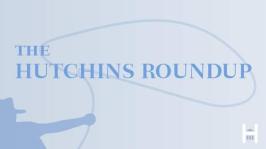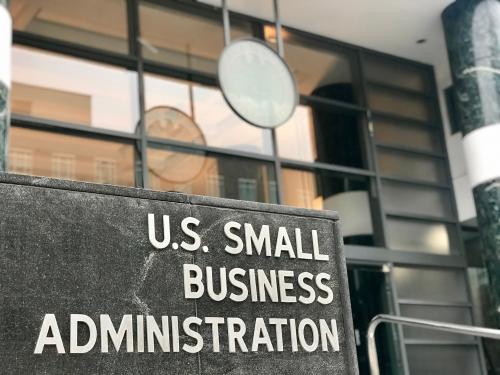What’s the latest thinking in fiscal and monetary policy? The Hutchins Roundup keeps you informed of the latest research, charts, and speeches. Want to receive the Hutchins Roundup as an email? Sign up here to get it in your inbox every Thursday.
Market value of US banks’ assets is about $2 trillion below book value
Using data on the asset and liability composition of all U.S. banks, Erica Xuewei Jiang at the University of Southern California and co-authors compare the market value of banks’ assets to their book value (the value recorded on their financial statements). The authors find that, because of the rise in interest rates, the market value of assets held across U.S. banks is $2 trillion less than their book value. Examining the case of the recently failed Silicon Valley Bank (SVB), the authors find that SVB was particularly vulnerable to the depreciation of long-term assets as 78% of their liabilities were funded by uninsured deposits. This raised concerns about potential losses and caused a bank run among their depositors. The authors estimate that if half of the uninsured depositors across the U.S. decide to withdraw their funds in a similar fashion, it would put $300 billion of insured deposits across 190 banks at risk. “Overall, these calculations suggest that recent declines in bank asset values significantly increased the fragility of the U.S. banking system to uninsured depositors’ runs,” they conclude.
Quantitative easing may increase liquidity risk after support ends
Viral V. Acharya of New York University, Sascha Steffen of the Frankfurt School of Finance & Management, and Rahul S. Chauhan and Raghuram Rajan of the University of Chicago investigate the effects of quantitative easing and tightening (QE and QT) on bank balance sheets from 2009 to 2021. They find that the increase in bank reserves resulting from QE led to an increase in deposits and credit lines that are not easily reversed with QT, which implies a greater need for the central bank to provide liquidity in the event of a future crisis. Specifically, the authors show that a 10% increase in reserves over a year is associated with a 1.4% increase in deposits and a 0.8% increase in credit line volume. They argue that the sharp run-up in deposit-to-reserve ratios after QE3 points to this phenomenon causing, or at least amplifying, the spike in Treasury repo rates in September 2019 and “dash for cash” in March 2020. Acknowledging the tradeoff between financial stability and monetary objectives, the authors say, “[P]olicy should focus both on slowing the rise of demandable claims written by banks during QE (vulnerability) and reducing constraints on the flow of inter-bank liquidity during QT (stress).”
Reminder letters boost mortgage refinancing
Many mortgage holders do not refinance when interest rates decrease, leaving substantial savings on the table and limiting the potency of monetary policy. In a field experiment of 12,000 Irish households, Shane Byrne of the Central Bank of Ireland and co-authors find that sending reminder letters to mortgage holders about their options increased refinancing rates by 76%, from just under 8.9% to 15.7%. The authors further estimate that the reminder increased consumption by €600 in the first year for the average household that refinanced. The results suggest that targeted communications from central banks may help amplify the power of monetary easing.
Chart of the week: How much stock market moves during Fed chairs’ press conferences
Chart courtesy of Namrata Narain and Kunal Sangani
Quote of the week:
“[T]he intermeeting data on inflation and the labor market came in stronger than expected, and before the recent events, we were clearly on track to continue with ongoing rate hikes. In fact, as of a couple of weeks ago, it looked like we’d need to raise rates over the course of the year more than we’d expected at the time of the SEP [Summary of Economic Projections] in the December meeting. We are committed to restoring price stability, and all of the evidence says that the public has confidence that we will do so – that we will bring inflation down to 2% over time. It is important that we sustain that confidence with our actions as well as our words,” says Jerome Powell, Chair of the Federal Reserve Board.
“So, we also assess, as I mentioned, that the events of the last two weeks are likely to result in some tightening conditions for households and businesses and thereby weigh on demand, on the labor market, and on inflation. Such a tightening in financial conditions would work in the same direction as rate tightening. In principle, as a matter of fact you can think of it as being equivalent of a rate hike or perhaps more than that. Of course, it’s not possible to make that assessment today with any precision whatsoever. So, our decision was to move ahead with the 25-basis point hike and to change our guidance… from ‘ongoing’ hikes to…‘some [additional] policy firming may be appropriate.’ Going forward… in assessing the need for further hikes, we will be focused, as always, on the incoming data and the evolving outlook and, in particular, our assessment of the actual and expected effects of credit tightening.”
The Brookings Institution is financed through the support of a diverse array of foundations, corporations, governments, individuals, as well as an endowment. A list of donors can be found in our annual reports published online here. The findings, interpretations, and conclusions in this report are solely those of its author(s) and are not influenced by any donation.
The Brookings Institution is committed to quality, independence, and impact.
We are supported by a diverse array of funders. In line with our values and policies, each Brookings publication represents the sole views of its author(s).









Commentary
Hutchins Roundup: Uninsured depositor runs, quantitative easing, and more
March 23, 2023